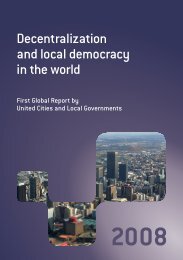Making Cities Resilient Report 2012
Making Cities Resilient Report 2012
Making Cities Resilient Report 2012
You also want an ePaper? Increase the reach of your titles
YUMPU automatically turns print PDFs into web optimized ePapers that Google loves.
CHAPTER 1 | Enabling conditions for building resilience<br />
A high turnover in leadership was noted as one of the chief barriers to sustaining urban risk reduction<br />
programmes by Makati City, Philippines; Quito, Ecuador; and Kathmandu, Nepal, which recently completed<br />
a one-year City-to-City Sharing Initiative, sponsored by the World Bank Global Facility for Disaster Reduction<br />
and Recovery (See Box 1.4). Mumbai has faced similar challenges, such as the need for informed and<br />
trained local authorities to coordinate long-term disaster risk reduction actions (24). There is no doubt that<br />
training helps, but in order to build municipal capacity for risk reduction, knowledge and learning must go<br />
beyond elected officials to reach technical and professional staff within these municipalities.<br />
Box 1.2 : Santa Tecla, El Salvador: The frequency of hazards impacts<br />
political will and electoral pressure<br />
In Santa Tecla, El Salvador, a 7.5 magnitude earthquake in 2001 claimed 720 victims, triggering a high level<br />
of community participation in public debates about the direction of risk reduction and urban development<br />
in the municipality. Santa Tecla’s Mayor, Oscar Ortiz (a Champion of the ‘<strong>Making</strong> <strong>Cities</strong> <strong>Resilient</strong>’ Campaign),<br />
took a strong leadership role in the response and recovery work with wide participation of local stakeholders.<br />
Taking the opportunity to strengthen the city’s normative frameworks, risk reduction plans and policies,<br />
he organised reconstruction committees that included the participation of the private sector, churches,<br />
NGOs and the local government. An action plan was tailored to the population’s needs and a community<br />
debate – Santa Tecla for the Future—revolved around reconstruction and other opportunities to create a<br />
city in line with sustainable development goals.<br />
The Mayor stated: “Santa Tecla will never be the same, it will be better.” This conviction gave the community<br />
the will and power to move forward with risk reduction policies. The Mayor has been re-elected every time<br />
since then.<br />
Lessons learned included the following: although disasters hurt, let’s turn them into a development<br />
opportunity; reconstruction must include the vision, resources, capacity and commitment of all;<br />
international cooperation is important, but the community’ strength is the key factor for success;<br />
transformational leadership is fundamental at the political, citizen, technical and business level;<br />
development is a long- term commitment; disaster risk management should be inclusive of all actors;<br />
citizen participation is key for a successful sustainable development plan.<br />
Box 1.3 : Dialogue contributes to sustainability in Chile’s Valle de Itata<br />
The Valle de Itata (Chile) was close to the epicentre of the February 2010 earthquake and tsunami (the<br />
latter accounted for most of the deaths). On the first anniversary of the event, a national multi-stakeholder<br />
dialogue began with international, national and local government counterparts, academics and civil<br />
society to discuss the reconstruction efforts, lessons learned and how to improve policies. The <strong>Making</strong><br />
<strong>Cities</strong> resilient Campaign was launched in the region.<br />
As a follow-up, staff from 10 municipalities are now enrolled in a training programme supported by<br />
international Campaign partners. This training programme built on local sustainable development<br />
practices, the Handbook for Local Government Leaders and the Ten Essentials, together with experience<br />
from the region. A monthly ‘Dialogue on Risk’ has begun in which all municipalities participate; they also<br />
directly fund the Dialogue. For the Itata Valley Association of Municipalities, the Campaign created a space<br />
to promote actions that build resilience and contribute to a culture of prevention. They have learned<br />
the lesson that communities cannot afford to wait for a disaster to strike and then be forced to work<br />
under pressure; rather they must be prepared in advance of an event. (See Box 5.1 on Quirihue’s Communal<br />
Development Plan).<br />
<strong>Making</strong> <strong>Cities</strong> <strong>Resilient</strong> <strong>Report</strong> <strong>2012</strong> | 19

















